This was published 6 years ago
Dancing with horses: The Spanish Riding School of Vienna
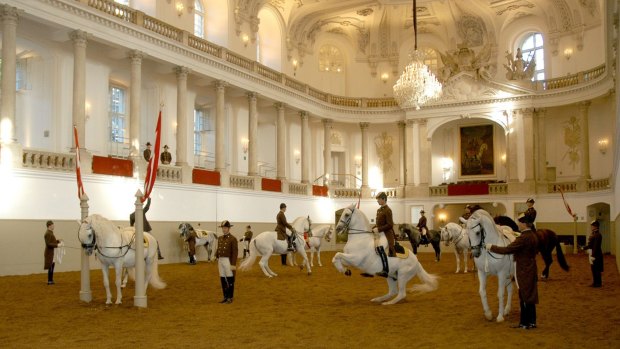
Lipizzaner stallions performing at the Spanish Riding School.
The Lipizzaner stallions enter the arena, each a mirror image of the other as they perform a pas de deux to classical Viennese music. Following on their tails is a novice pair, heads high and hindquarters sashaying, the dappled markings on their legs emphasising their youth. Without warning, one of the youngsters gives a buck, triggering a rear-end explosion that would do any schoolboy proud. The other prankster shies away, feigning surprise and rolling his eyes in mock horror.
These rising stars seem to have perfected the airs, but not the graces.
It is the morning performance at the Spanish Riding School of Vienna, where the "dancing white horses" are going through their paces. Founded in 1565 to teach the art of Haute école, the classical horsemanship practiced at the school was included in 2015 on UNESCO's Representative List of the Intangible Cultural Heritage of Humanity.
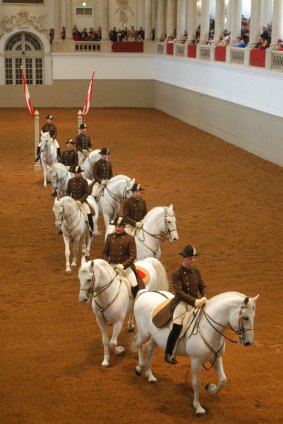
Lipizzaner stallions performing.
From my seat I take it all in – the thud of hooves, the snort of breaths, the ripple of haunches, swept up and taken back to a time when I too once owned and rode horses. Watching the half-passes, pirouettes and passages I feel my calves squeeze and hands soften on imaginary reins, sensations once ingrained never forgotten.
Under the gleaming chandeliers the horses become ballet dancers, all rise and fall and rhythm, the next moment they are Pegasus, floating through the air on unseen wings. Through it all runs a grace and strength that strikes at my very soul.
And to think this 450-year-old art form was almost lost during World War II.
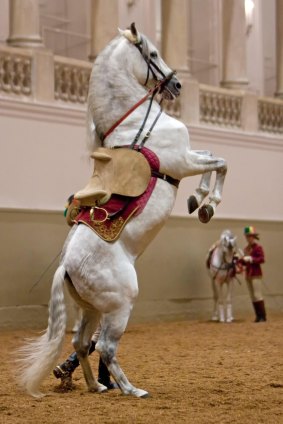
A Lipizzaner stallion struts his stuff.Credit: Alamy
It is a well-known fact that during the war the Nazis stole jewellery, gold and artworks, what is relatively unknown is that they also hijacked horses. With a grand plan to create their own super-race of horses, they smuggled Lipizzaner mares from the school's Piber stud in western Styria, Austria, to a base in the Czechoslovakian town of Hostau.
In bomb-weary Vienna the stallions were also under threat, hunkered down through heavy air raids before being secreted away by the school director Colonel Alois Podhajsky to the small town of St Martin, 300 kilometres away. Later, Podhajsky would recount these days in his memoir My Dancing White Horses.
In the dying days of the war an even bigger threat emerged, the advancing Soviet army, considered both ruthless and ravenous, with a potential appetite for horsemeat. The defeated Germans were so concerned they enlisted the help of Colonel George Patton from the US, a fellow horse-lover who hatched a covert mission to rescue the mares and protect the stallions. It would take 10 years for the stallions to return to their home at the Spanish Riding School in Vienna.
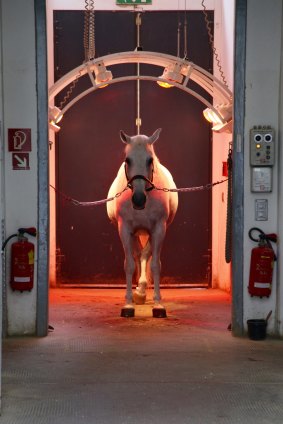
Enjoying a UV treatment in the solarium.Credit: Kerry van der Jagt
After the performance I take a behind-the-scenes tour where I learn more about the breeding and training programs. "The Lipizzaner foals are born at Piber Federal Stud," explains our guide Pierre. "By age four the best stallions are selected and transferred to Vienna, where it takes about six years of training for them to become a School Stallion."
We learn that the school's name comes from the 16th century horses that were imported from Spain, and that foals are born dark, gradually lightening as the greying process takes place. Even today, superstition dictates that the stables must keep two bay stallions to ensure the riding school will prosper.
Wandering the arcade courtyard a few noble heads peak over the half-doors, as interested in us as we are in them. Even though we are not allowed to touch, we are close enough to appreciate the subtle variations in expression and statue. One has a Billy Idol punk fringe; another a David Lee Roth mane. All have rock star presence.
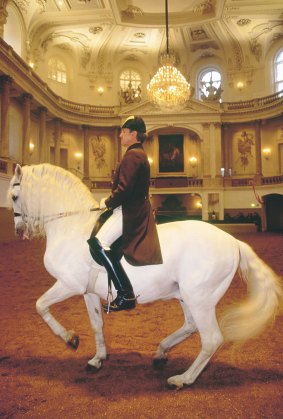
Horses under the gleaming chandeliers at the Spanish Riding School of Vienna display grace and strength.
My best memory is catching a glimpse of a rider having a quiet moment with one of his steeds – stroking the forelock as the stallion nuzzles his shoulder.
Watching from a distance I can't help think about the war days, when two opposing armies put aside their differences to save the Lipizzaners from a third, more dire threat. After the horses were rescued, Colonel Charles Reed was asked why he risked everything to save them. "We were so tired of death and destruction," he replied, "we wanted to do something beautiful."
TRIP NOTES
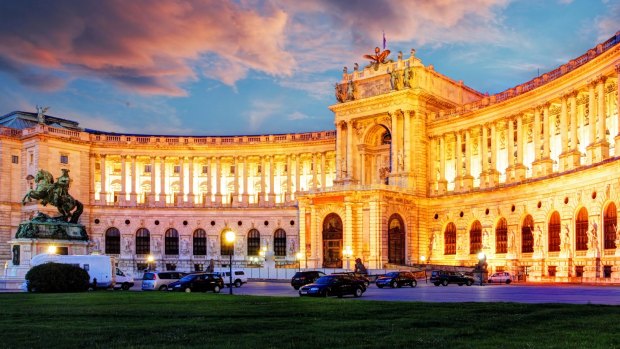
Hofburg palace at dusk, part of Historic entrance way to the Spanish Riding School.Credit: iStock
MORE
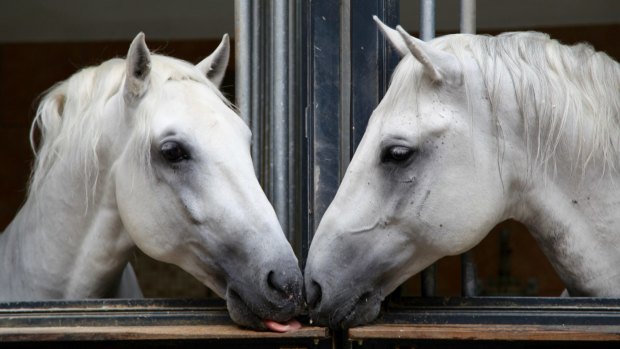
Stallions in the stables.Credit: Kerry van der Jagt
VISIT
The Spanish Riding School program is extensive and many need to be booked in advance. Performances range between €50-€217, with standing places from €25. Guided tours cost €18. Tickets for morning exercise with music cost €15 and cannot be booked in advance. Note: the stallions take a well-earned rest over summer. See srs.at
FLY
Cathay Pacific flies frequently from Sydney and Melbourne, via Hong Kong, to key European gateways, including arrival and departure points for Avalon Waterways' cruises. See cathaypacific.com.au
CRUISE
Avalon Waterways' eight-day Taste of the Danube starts at $2901 a person, including two nights in Vienna, a three-night cruise on the Danube and two nights in Budapest. Guests will need to make their own arrangements to visit the Spanish Riding School. Phone 1 300 230 234, see avalonwaterways.com.au
Kerry van der Jagt was a guest of Avalon Waterways and the Vienna Tourist Board.
Sign up for the Traveller Deals newsletter
Get exclusive travel deals delivered straight to your inbox. Sign up now.